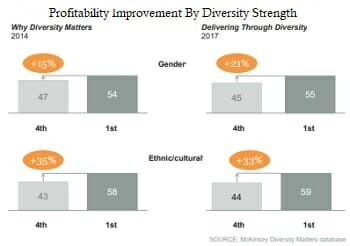The US Census Bureau projects that by 2050, the country will have no racial or ethnic majority. Therefore, companies in the US are making strides towards implementing diverse hiring practices and initiatives in their workplaces. But, there’s still a long way to go, and most US companies are still behind the curve on promoting diverse workforces that reflect the country’s changing demographics. That means they’re missing out on the benefits that promoting a diverse workforce brings – from fairer, more welcoming work environments to bigger profits.
It’s no secret that the more diverse and varied a workplace is, the more viewpoints, experiences and ideas they’ll have to share. That’s as true for society as it is for businesses and it also explains why the world’s most successful economic powerhouses – like New York, London, Dubai – are also the some of the world’s most diverse cities.
It only makes sense that a workforce comprised of people with varying backgrounds and experiences (not just different ethnicities and races) would result in more creative ideas and solutions, as well as fresh insights – vital ingredients for businesses valuing innovation and outside-the-box thinking, such as startups.
In fact, a McKinsey study found that a company in the top quarter for gender diversity among executives is 21% more likely to perform above the national industry median for profitability than one in the bottom quartile. If a company’s representation of varying cultures/ethnicities in the ranks was in the top quartile of the survey, that increased to 33%.
If they ranked at the bottom in terms of diversity and representation? Then the opposite was true; companies were 29% less likely to outperform their competitors.
The numbers are similar when discussing gender representation. Women, for example, are still hired much less often for entry-level jobs, despite women now representing 57% of college graduates. By the time you get to the C-suite, women only represent 1 in 5 executives – and women of color only 1 in 30.
Yet, a recent study showed that those businesses that had more female executives were more profitable. And it’s not as if there’s no shortage of women in the workforce, considering that women are just over 50% of the US population, and women of color represent 20% – not 3%.
So, while they aren’t the only factors affecting the bottom line, diversity and inclusion in the workplace no doubt play significant parts in creating growth and improving performance. Thus, why is it that so many American companies still haven’t taken the steps to encourage more diversity and inclusion in the workplace?
More than just diversity hiring
Even with fairness and inclusion aside, the advantages created by varied viewpoints and ideas should be attractive enough to employers to start cultivating them. Many are simply unaware of the impact a diverse workforce can have. It’s also possible they just don’t know how to encourage one. Doing so requires more than just hiring the right people; it also takes active and ongoing effort to cultivate an environment in which everyone is comfortable sharing their ideas and talents.
Employers looking to create such an environment might start simply by fostering a welcoming workplace and one that encourages employees to be friendly with each other engaged in their work (things that go beyond social outings and ping-pong tables).
Instead, they can make room for flexibility and autonomy in work. The lengths to which even a small measure of both can help create satisfied and more productive workers has been routinely documented. And the more a work environment promotes and inspires growth through continual learning and mentorship, the more employees feel empowered and like an active, valuable part of their work.
In fact, employee engagement is also a huge indicator of productivity and success of teams as it can increase operating income 19.2%, while low employee engagement can drop performance up to 32.7%.
Here’s how to integrate diversity and inclusion into your business:
Diversity
- Make a commitment to having your workforce resemble the community you operate in, and if you do international business, make sure the communities you do business with abroad are represented as well.
- Ask your existing employees for referrals — they will have a good idea in regard to culture and fit.
- Reach out to community organizations who may have ideas about where to find great diverse candidates.
- Diversity training in the workplace is critical to increase employee horizons and foster cooperation.
Inclusion
- Make sure employees have been properly introduced and give them opportunities to get to know one another better.
- Ensure that all employees master new skills and can use them together adequately.
- Involve everyone in communications unless conveying sensitive information.
- Modify activities when necessary so that everyone can participate.
- Actively encourage collaboration, assistance, cooperation, and “open-door” policies.
In the end, it shouldn’t be surprising that an inclusive workplace filled with diversity of thought and background can have such an impact on the bottom line. It would behoove organizations and managers to start molding workplaces that reflect society’s demographic changes. The changes they see, both in workplace culture and on business outcomes, might surprise them.
